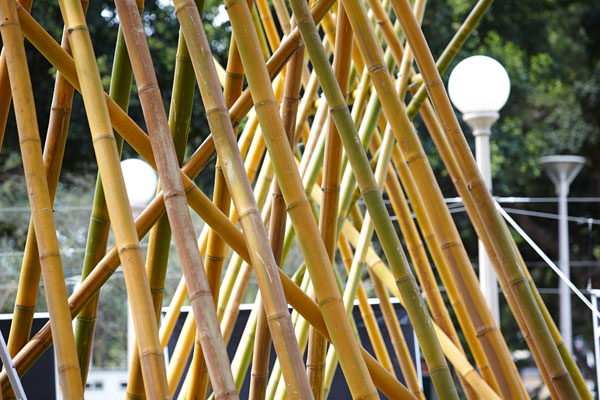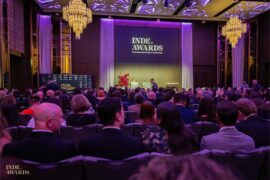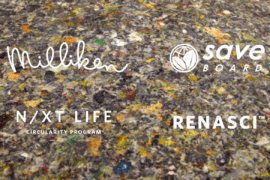In October, the annual Night Noodle Markets were held in Sydney and Melbourne. Edwards Moore were chosen to design and realise an enclosure for them.

December 8th, 2014
The brief asked for a temporary structure, which Edwards Moore decided to use bamboo for, creating a set of tee-pee like structures enhanced by lighting. We asked them about the design process. Student architect Will Christian fills us in.
– Please tell us about your decision to use bamboo and how this feeds into the overall design
The decision to use the bamboo came in one of the initial concept sketches and subsequent model, which drew inspiration from the formation of chopsticks. When in hand, the chopsticks’ tension, fanning motion and extension of the hand; a tool to eat with, were extracted and brought to the presentation concept. Bamboo was a material that fitted the themes we were reckoning with and allowed a connectivity and pliancy that wasn’t possible with timber or steel.
– How did the local climate and influence your design? Did your response differ between Sydney and Melbourne?
Being an open air event it was not included in our brief that it was to be a protective structure; there were very few installations that had anything so much as a solid roof.
The challenges that we faced in Melbourne were similar to those in Sydney. Difference in site aside the climate the only real threatening issue was wind resistance and incorporating that into the design.
-What has the response been to these structures? Are you pleased with the way they’ve been used?
Yes – they were a spectacle and a point of interest even for those who weren’t subscribers; which is exactly what we wanted. Even during construction we had more than a dozen passers-by who stopped us to ask about the bamboo and what we were up to – it was very exciting seeing people’s reactions to our work even before it was finished. One couple on holiday from the Chicago in the States wanted every detail and insisted on a photo of us with the pavilions behind.
-How has the fact this is a temporary structure influenced your design?
I would say that we were aware but it by no means influenced how it was assembled..
-What were the main challenges and how did you overcome them?
Working with such an unrefined material as compared to milled timber, every piece of bamboo was different and treated as unique. To amplify this we used self-tapping coach bolts which some might say is primitive and uninventive but it showcases the pure, natural formation of something that is grown and untreated. Imperfections, ridges and all, the bamboo is the cornerstone of our project and we were adamant to produce something as effortless as its growth for our clients.
All about that bamboo; very few had experience with it as a material in the state we were using it. Bamboo is extremely strong, it can withstand a vertical load of 1tonne. Being an open event we needed to comply with wind standards for outdoor structures and strategically securing the bamboo to be self-supporting.
– What about this space makes it a special and personal project for you or the lead architect/designer?
For us the use of bamboo was a pioneering moment. Using it at a comparably large scale compared with the size of the project was a milestone in which we learnt what was possible and how that can be further developed for later projects; maybe even permanent ones.
The space has it’s greatest effect when you are immersed beneath and next to these alluring objects and using them to encapsulate an environment that brings the food of the market to a higher level of enjoyment – to watch things beyond within a sanctuary; whilst being able to reside to a table with your friends and family. From the lights above you casting a shadow alongside the bamboo, you become part of the space and amplify the theatrics of the sanctuary in your movement.
Photography by Fraser Marsden
Edwards Moore
edwardsmoore.com
INDESIGN is on instagram
Follow @indesignlive
A searchable and comprehensive guide for specifying leading products and their suppliers
Keep up to date with the latest and greatest from our industry BFF's!

How can design empower the individual in a workplace transforming from a place to an activity? Here, Design Director Joel Sampson reveals how prioritising human needs – including agency, privacy, pause and connection – and leveraging responsive spatial solutions like the Herman Miller Bay Work Pod is key to crafting engaging and radically inclusive hybrid environments.
The new range features slabs with warm, earthy palettes that lend a sense of organic luxury to every space.
Don’t miss your opportunity to hear from industry experts in Designer Rugs Evolve Award Workshops!
A leading supplier of high quality textiles, Kvadrat Maharam Australia is now servicing the New Zealand specification market, following the recent appointment of a dedicated New Zealand Sales Representative.
Project Team: Andrew Owens, Gerard Page, Nick Kough Square Metres: 950m2 Location: Turramurra Avenue, Turramurra, NSW Expected completion date: Dec 2010 From the Architects: “This 27 unit development makes the most of a fairly constrained site. Significant set backs from the street dictated the building be consolidated towards the South West corner of the site […]
The internet never sleeps! Here's the stuff you might have missed

As a supporter of the 2025 INDE.Awards, COLORBOND® steel recognises the importance of the next generation of architects who are leading the way in creativity and innovation to help design and sustain our future.

Developed by Milliken in partnership with saveBOARD, Renasci™ is a breakthrough circular flooring product made from carpet and soft plastics waste – designed to be repeatedly recycled.